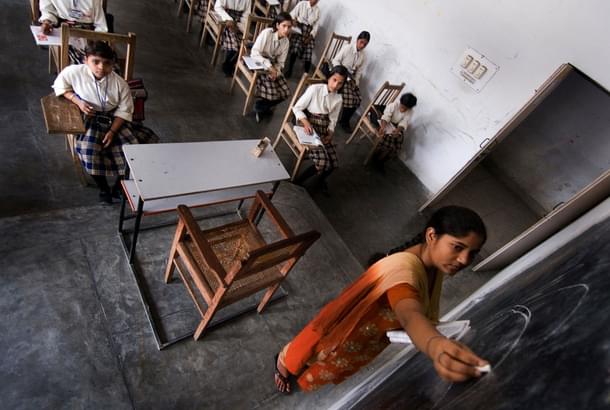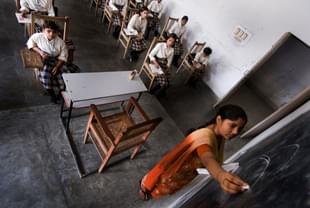Ideas
Attention Parents! A 10-Point Checklist To Ensure Schools Are Safe For Children
Vishnu Karthik
Sep 11, 2017, 08:48 PM | Updated 08:47 PM IST
Save & read from anywhere!
Bookmark stories for easy access on any device or the Swarajya app.


The brutal murder of a 7-year-old in a Gurgaon school and the rape of a 5-year-old in a Delhi school have once again reminded us of how unsafe schools can be for its children. It brings back memories of the twin drowning cases last year – one in a Delhi school (which is part of the same chain in which the 7-year-old was murdered) and the other in a government-run public school. These tragedies in school campuses aren’t just limited to schools in India but also occur in some of the developed countries as well. The central government on its part has passed laws such as Protection of Children against Sexual Offences (POCSO Act) and many state and city governments have issued school safety guidelines. Yet, the efficacy of such laws is very poor given the state’s poor capacity for implementation of such laws and guidelines. Having robust state mandated laws and protocols are a necessary condition but not a sufficient condition to protect our children in school. For example, while every state government mandates police verification for school teaching staff, very few police departments have a robust and a timely police verification system. While schools may find ways to get the police complete the verification of its staff, it doesn't entirely eliminate the possibility of a criminal sneaking into the school’s payrolls. Another example is the recommended use of CCTVs by various governments. While CCTVs are important, they are often used retrospectively to analyse an offence rather than proactively to prevent one.
But there are a few things parents can and should do to ensure that the school is safe for their children – from sexual offences, bullying, corporal punishment, physical safety, natural calamities and medical emergencies. I’m sharing a few best practices some safe schools follow around the world:
1. Safe schools often have a matured and an independent safety committee with representations from parents, teachers and expert consultants. This committee has a mandate to work with the school on developing metrics for safety audits, process and policy design and creating buy-in from parent community on safety issues. But the primary responsibility of this committee is to help the school balance the safety concerns against curriculum requirements. Theoretically, the safest school is the one that locks its kids and teachers in a single room with no movement outside in corridors or playground! But that was not what schools are built for. Many good schools have totally abandoned any experiential and outdoor learning in favour traditional classrooms teaching because they are not confident of their safety procedures. A good parent safety committee must provide this support and comfort to schools by encouraging parents to volunteer as tour marshals.
2. Much of a school’s safety is incidental upon its environmental design and its architecture. A school should have no dead zones – areas nobody has a visibility over. For example, there should be no doors that can be locked (except for individual bathroom units), no doors without transparent/glass panels, no rooms within rooms in the entire campus. Much of the crimes in schools can be prevented over the principle of ‘see and be seen’. Corridors and classrooms that encourage a natural surveillance provide the best deterrence. CCTV cameras should cover all the common areas especially remote or less populated areas. Unfortunately, most CCTVs are rendered useless due to their poor positioning and poor quality of images. Also, CCTVs are effective only when there are pairs of eyes scanning the live video feed. As parents, talk about its environmental design to your school.
3. A proven method to build safe schools around the world is to have a culture of teachers ‘walking around’ during breaks, transition times, assembly time and dispersals at the end of the school. Research across schools in many geographies have time and again proven that schools that have dedicated teacher patrol routines during break and transition time drastically reduce bullying, physical accidents etc. Teacher patrols also build a large culture of care in the school community. Every student knows that someone is always watching out for us. Unfortunately, Indian schools unlike their counterparts in the west, do not focus on this protocol. Many of the state’s safety guidelines are silent on teacher patrols. As a parent, work with your school to ensure that there are caring adults walking around the campus, especially in areas where offences could happen – bathrooms, gym room, labs, deserted areas behind the school building etc.
4. Safety doesn't happen by accident. It happens through disciplined and consistent practice. Safe schools are diligent about their scheduled and unscheduled safety drills and training. Everyone in the community takes these drills seriously. Safe schools are also serious about sharing the lessons of safety drills and tweaking their processes. Parents should check the track record and findings of such drills in their schools.
5. Often, Indian schools relegate the management of its blue collared staff to third party contractors building very little engagement and ownership among them. As much as a rigorous recruitment process, safe schools ensure continued engagement and training of its blue collared workers. Training not only includes protocols and procedure training, but also training on yoga, meditation and spirituality. As a parent knows, that safety is more about culture than it is about processes. Ask your school — how do they ensure engagement and ownership among its blue collared workers?
6. Teachers who can teach their subject well need not necessarily be good at handling child safety issues. Does your school constantly invest in training and sensitising of teachers? Are all the teachers able to identify a child in distress? Do they have the maturity to sensitively handle issues and protect the child as per law and child rights guidelines? As a parent, ask your school on the training the school has invested in. Talk to the teachers to get a sense if the school has well articulated emergency procedures that are well understood by all. Are safety and child rights a discussion point in teacher meetings?
7. Does your school have a ‘no touch’ policy? As crude it may sound, most safe schools will have a no touch policy. No teacher or staff, irrespective of gender, is allowed to touch any child for any reason whatsoever. While it may sound very conservative, it does, for a school system as a whole, ensure safety of the child (and the teacher too in cases of false/wrong accusations). Parents should have a dialogue with the school on what their policy on student teacher touch is.
8. Safe schools do a good job of enforcing access controls in different parts of the school. No access zones areas are clearly demarcated — like zero access for bus drivers/conductors to children’s restrooms. Dead zones are adequately barricaded and rights of access are articulated visually. As a parent, see if you are experiencing these controls when you visit the school.
9. While all Indian schools take student attendance in the morning, most schools do not have a robust mechanism to track students between class periods. No wonder many of the recent accidents or abuses in Indian schools happened in between classes. Some of the good practices include attendance in every class, corridor passes for stepping out of classes etc. Such tracking system not only makes the individual teacher accountable for each child in the class, but it also makes students accountable for their movement during class time.
10. Lastly, no school, like anything else in life, can guarantee absolute safety. While the school may do everything in letter and spirit to substantially decrease the probability of an accident, it may not be able to totally eliminate the possibility of an accident. Safety is everybody’s business — not just the school’s or the government’s. Parents should not delude themselves by abdicating or outsourcing their child’s safety to the school. As a parent, ensure that your children are empowered to deal with any situation. Invest time in teaching them on how to keep themselves safe. Take efforts to build your own understanding of various issued faced by children of today. Know that over 99.5 per cent of offences or accidents happen in home environments and not schools. Are you, as a parent prepared to protect and empower your child?
This article was first published in medium.com and has been republished here with permission.





